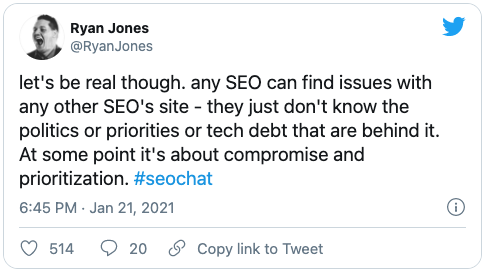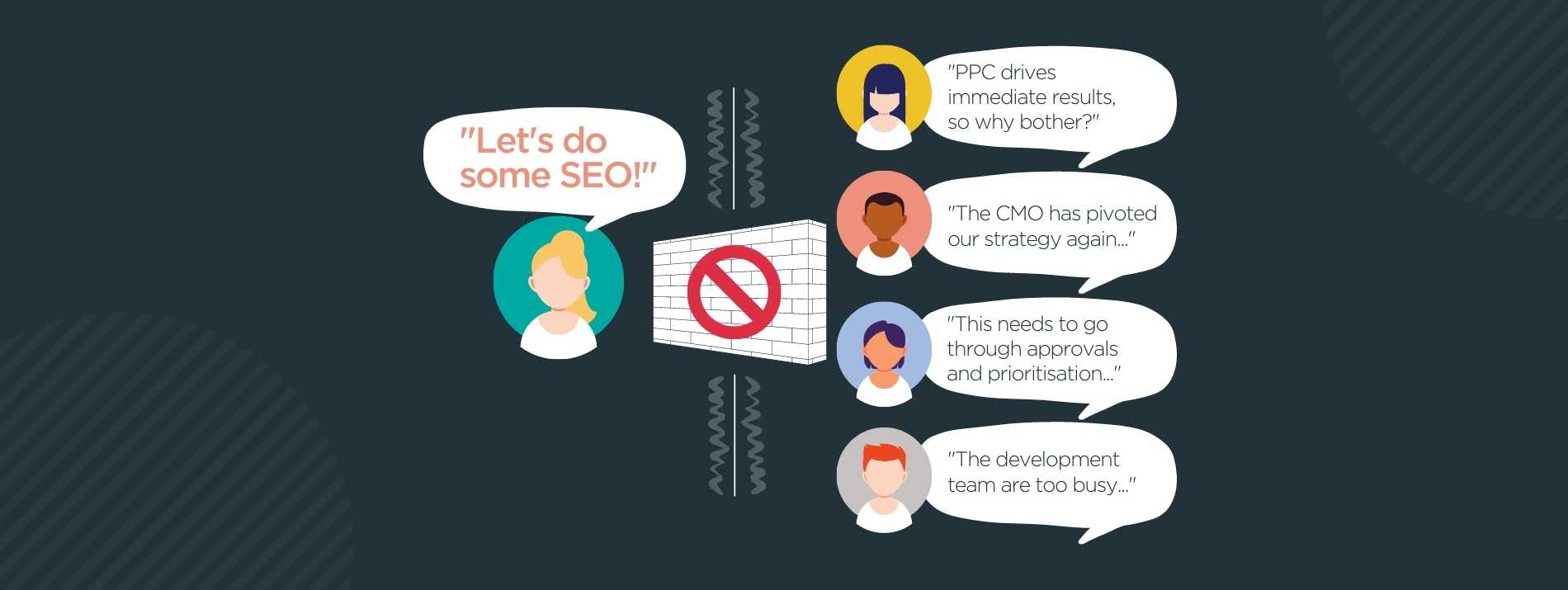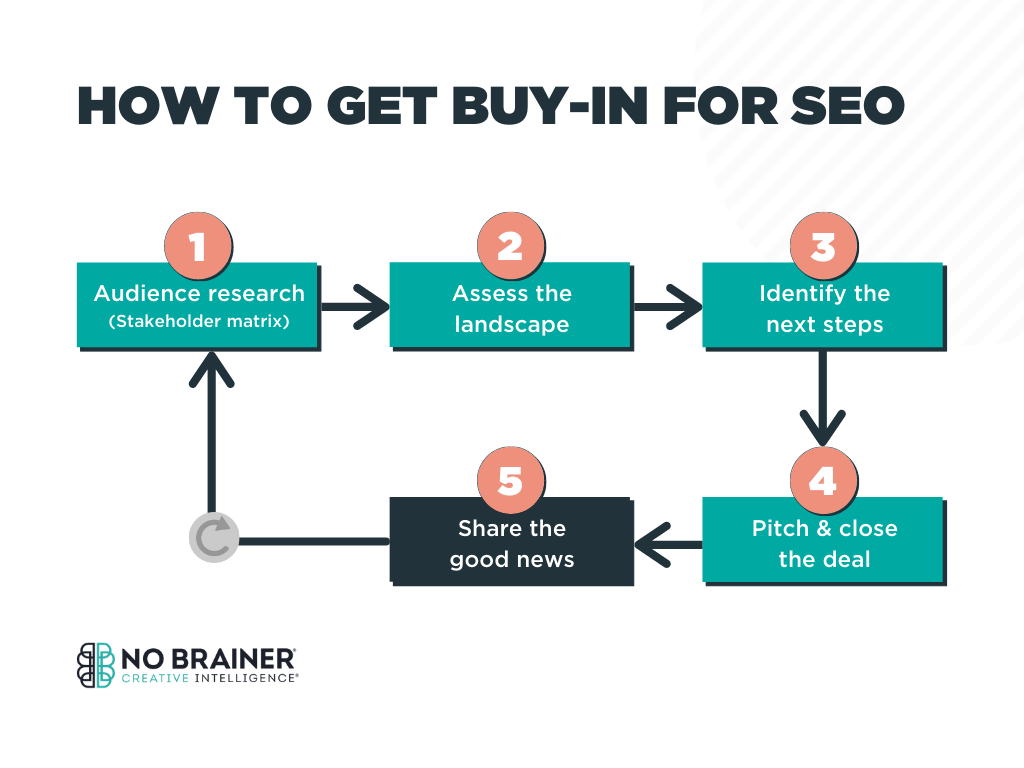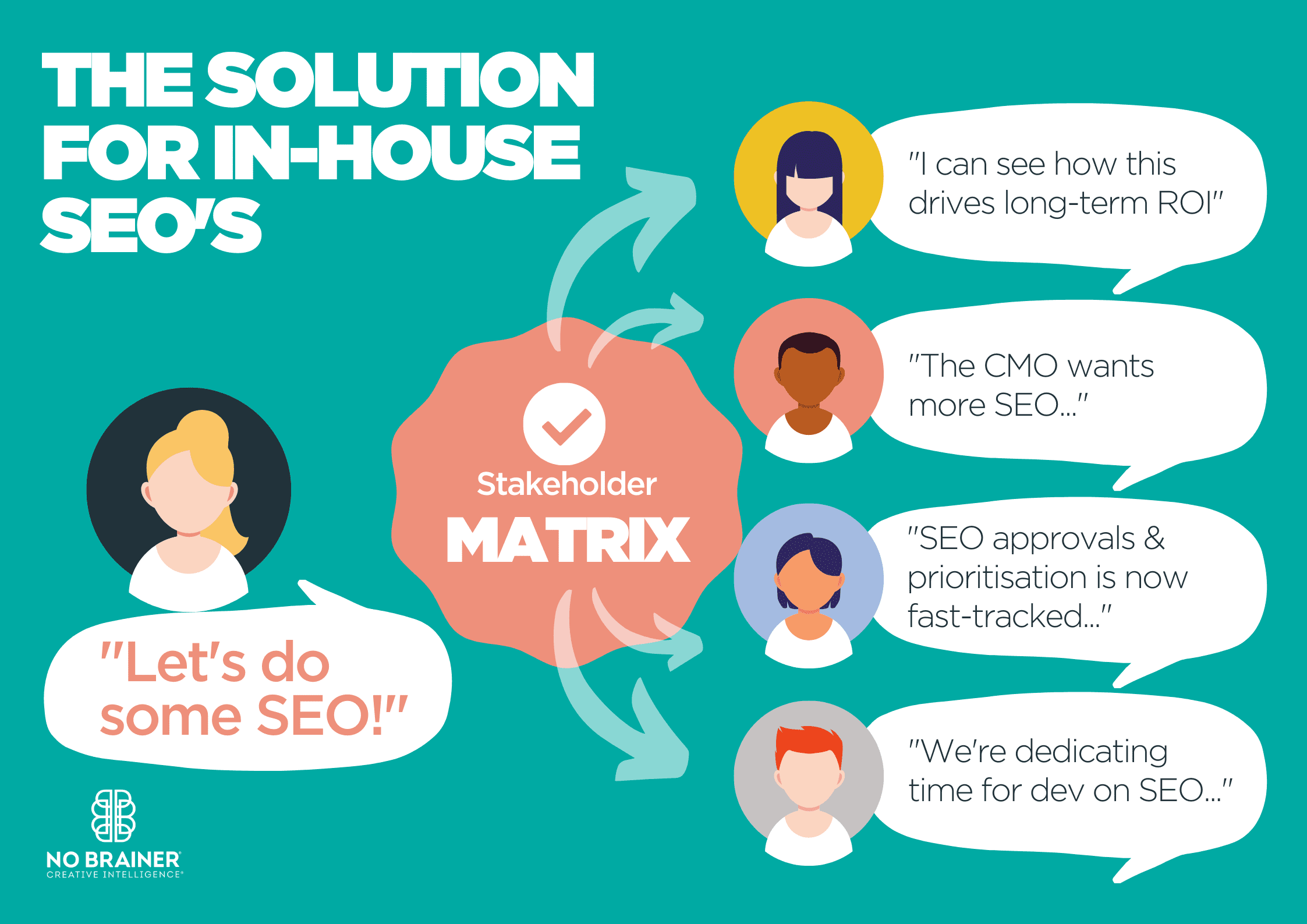
Whatever is blocking you, whether it’s lack of team knowledge, internal politics or perhaps the sheer level of resource, it’s bloody tough to rally the troops and deliver growth in organic search without wider company support and buy-in. But remember, you are not alone.
I’ve tackled this challenge at multiple organisations during my career, so I wanted to share the tips and tricks that really helped me to overcome some of the common obstacles and hurdles that ultimately gets SEO services embedded within an organisation. Even if you’re just starting your journey into SEO, or you’ve been doing this for some time, hopefully this’ll help!
Where to begin? In a nutshell: Start marketing SEO to your colleagues, and yes, even the Executive team
Before you can start “marketing” SEO, you need to understand your audience and how best to market to them. So, whether you “get” marketing or not, I hate to break it to you, but you’re in the thick of it now. Whether you’re looking at ecommerce SEO or your ultimate goal is generating quality leads through your site, the principles on getting buy-in are the same.
Our 5-step process to get buy-in for SEO (and prove its value)
Based on my experience, and using a few handy tools, we’ve shaped a five-step process for you to use to get that all-important approval, build long-lasting alliances and even transform your biggest blockers into SEO champions.
Although it is simple, each step requires time, effort and patience before you’ll reach the finish line – after all, you’re changing both hearts and minds here. Let’s get started…
Step 1: Know your audience
First things first, let’s think about your target audience: When something is so clear and obvious to us techies, it’s sometimes easy to forget that, to others, you may as well be speaking a different language (Klingon anyone?).
We also forget that while we’re battling on with our own agenda, it’s forgivable to overlook that others are going through their own challenges. Take that example and overlay a lack of knowledge, especially if they don’t see it being useful to them – that can make it a tough sell, and that’s no-one’s fault. But – that’s where you have an opportunity to find common ground!
So, while you didn’t necessarily sign up to become an “SEO champion”, waving the flag and jumping up and down like a maniac; at some point soon, you’ll have to fire up PowerPoint, dust off your marketing skills and start speaking their language.
How to understand your audience: Setup a “Stakeholder matrix”
Before you can begin to turn people to your way of thinking, you need to get an understanding of who exactly it is you need to get “on side”. One thing I found particularly useful was a stakeholder matrix (inspired by The Content Strategy Toolkit from the talented Meghan Casey).
It’s a simple spreadsheet that lists each person that you believe is pivotal to getting SEO embedded, what their role is, whether they’re a blocker or an ally, and what’s important to them. Having this laid out will you to tailor your “pitch” for SEO so it connects with them, speaking their language – but I always find it useful to gets things clear in your own head on how to market to them.
I’ve set up a free stakeholder matrix spreadsheet to get things started – feel free to make a copy and tweak it to suit you (it’s Google Sheets)!
How to use the stakeholder matrix
- List your stakeholders, by both name and title, these should be the key people who you need “on-side”
- Map out their roles in your mission:
| Type | Details |
| Decision maker | The person who ultimately calls the shots and are responsible for overall performance – this could be the CMO and CTO, Marketing or IT Director or someone else entirely. |
| Influencer | They have the ear of the Decision Makers and could help push things forward. Heads of Departments (or similar) tend to fit into this, but don’t exclude their direct reports either. |
| Gatekeeper | This person could be key to unlocking those important relationships or hold helpful access or data (perhaps it’s the Head of Development, Scrum Master or someone with a personal connection that you could get to help support your cause). |
| Other | If they don’t meet the above, stick them in the “Other” bracket for now! (But make a note as to why they’re important) |
- List the type of role they have:
| Type | Details |
| Strategic | Are they the people who formulate the strategy to meet objectives and goals? If so, then they’re in this category. |
| Expert | These are your friendly neighbourhood Subject Matter Experts – like CMS editors, developers or specialist product owners. |
| Implementer | Very helpful dudes! Get to know these people, they’ll likely be implementing your SEO strategy. |
- Add some more details to the other columns, including:
- What concerns they may have around SEO i.e., PPC gives immediate results, the level of resource required is too high, or is it that there’s too many “unknowns” that concerns them.
- Topics – What would be good to chat through in a one to one? For example, what are the challenges in their role right now? Have they recently been promoted? How is meeting their objectives going?
- And finally (most importantly) – objectives: It could be “to continually drive an increase in conversions” or something more specific like “X website conversions by X date”. Hopefully, you have an organisation that gives that level of clarity on marketing objectives, but if not, keep it general to their role i.e. a Marketing Director will value more sales but for less and brand awareness (hello brand-terms), whereas a Head of Development may be looking to increase traffic to their website and keep it healthy.
- Status – the one you’ll need to keep coming back and keep up to date (based on your efforts above). But for now, take a look at the table below and assign them a status that best fits for now.
| Type | Details |
| Champion | Woo! This person not only gets SEO, but they’re also passionate about how it can help meet strategic objectives. This status is the ultimate goal for all of your stakeholders. |
| Gets it | Wow. You’ve cracked this one – they get why SEO is important and how it can help them. You just need to think about what it’d take to upgrade them to Champions! |
| Improving | You’ve started discussions and learning more about this person, helping them understand more about SEO. They’re a work in progress. |
| Derailer | These people need your help. They could be blocking important strategic growth, but it may be tricky to navigate – best ensure you have as much info as possible, so you can nudge them into improving and move upward from there! |
Phew – you’ve completed the majority of the matrix now and should have a clearer understanding of how best to crack it! Now let’s go further…
Step 2: Assessing the landscape
Before we get into the pitch, I wanted to highlight another consideration that is worth you making some notes on: You’ve understood the person, now understand the landscape they’re working in. The example focus here would be in a corporate landscape – and from my experience, it has the most complex variety of factors and challenges.
I’ve boiled it down to 4 landscape-related factors, and they’re rooted in:
- Resource (teams with no time for SEO)
- Politics (opposing views between departments that you need to be working together i.e., Marketing and Development teams)
- Budget (small budgets, or those who want to know the risk vs reward)
- Knowledge (gaps that can hinder your work (or is lost on them!))
How do you combat barriers in a corporate landscape?
No resource available
This is a tricky one because you’re not only trying to get them to pivot their strategy – you’re potentially asking them to recruit, and that is a long process that is hard to get over the line.
Instead, focus on how the business could work smarter and consider:
- Could they get an SEO agency to help support you?
- Could a good freelancer help in the short term to demonstrate value before investing more significantly?
- Can you drill down into your plans and give a view of impact vs resource?
Politics and SEO don’t mix
Ugh, politics. It’s another tricky one to navigate, especially if you’re new to the business. There are always added complexities in dealing with politics, because at their core, it’s often personal. Whether it’s the brand team and the developers not seeing eye to eye, or maybe there’s invisible friction between some of the Exec team – keep on making notes, and tread carefully. Never try to solve the politics or problems, you just need to get a few people on the same page because, essentially, it’ll make them look good (and who isn’t on board with that?).
That being said, your stakeholder matrix will get you in front of the right people, but if “people” aren’t your bag (maybe you’re a bit introverted), then make sure you have a solid plan of attack for each person you’d like to become an SEO champion. But be reassured that the matrix will be a great foundation to make sure you can easily (and confidently) connect with your audience – even the scary ones. So, take a deep breath, get all the facts in front of you, know that this will take time, and just be yourself. You’ve got this.
No budget for SEO?
We’ve all been here, right? The quickest way of addressing this is to leverage what you know about the stakeholders (see the matrix), then get an understanding of where their budgets are being spent now – and importantly, if SEO could do better. Along with this, consider how SEO can help other existing channels and how they can benefit SEO e.g. Digital PR activity for new products can work with an ecommerce SEO strategy.
For example, if they’re spending the majority of their acquisition budget on PPC/Paid Search, then there’s an opportunity for you to demonstrate market share, competitor analysis, forecasting (especially the important CPA differences). It only needs to be presented in a handful of slides (5 max) – keep it concise and as impactful as you can.
Not sure how to do an SEO forecast? Moz has a great free SEO forecasting template that generates a forecast for you (based on historical traffic).
Knowledge – where there’s gaps
Organic search is a “given” to a lot of companies, they take it for granted, and as SEOs it’s a frustration that we’re used to. But besides the initial frustration, there’s a cause to that effect – a lack of knowledge. That’s where you can help (see the next step).
Add some of these considerations to your pitch and notes sections – boy, will it help!
Step 3: Identifying the next steps for individual stakeholders
Now you have a good understanding of who your stakeholders are, and what it’d take to get their attention (and become an ally!), you need to start thinking about the best route to success.
First, identify those in your stakeholder matrix that you’ve set a status for. Do you think they’d get the most out of a workshop or official training – but perhaps the first port of call would be a one to one: To sit down, demonstrate your understanding of their needs and how SEO can help them hit those all-important objectives. If that lights a fire in them, move them into a workshop or training session – but it’s vital you keep them engaged, understand where they’re at (knowledge-wise) and keep building on that. After all, with great power comes great responsibility!
| Type | Details |
| One to one | A one to one is important for those who need to be guided more closely, discuss things in detail or if a tailored “pitch” was required |
| Workshop | A group get-together (like a “lunch and learn”) where you can up-skill teams and key stakeholders |
| Training | If a workshop just won’t cut it, they may need official training i.e., HTML, JavaScript etc. |
Step 4: The pitch process (closing the deal)
All that brilliant work is about to come to fruition, so let’s make sure the pitch is bang-on.
Leveraging those topics, concerns and objectives: think from your stakeholders’ perspective and how SEO can become the solution (or part of it) to their challenges and objectives.
But remember: Always back things up, or lead with data – no-one can dispute the facts (it may even surprise and delight a few folks).
Ask yourself:
- Based on topics, is there something that you can tie back to SEO? For example, if brand awareness is in decline, would a Digital PR campaign (that’s aligned to your strategy too) get them engaged? Are there examples you could show, ideas you’ve had – or even something more tangible like a concept and forecasted impact?
- Concerns are a bit trickier; this is where you need to put your psychologist’s hat on. Are they concerned about timings, budget or maybe resource? How can you combat that, or show ROI for SEO? A typical one is Paid Search vs. Organic – people often see it as a risk. After all, PPC can deliver immediate benefits. But you could perhaps forecast the reduction in Cost Per Acquisition if they’d invested in SEO, and that it pays longer-term (even showing the PPC value of traffic that organic can/does deliver). Another consideration could be the competition – are they in a highly competitive market? Can your research demonstrate just how much they need SEO in order to crack the market? I’ve found this one, in particular, to be hugely impactful.
- Objectives. This is the slightly easier one! However, you may need to think outside the box a little and explore (even brainstorm) how SEO can help them achieve them. Need more brand visibility and/or awareness? There’s an SEO/link building campaign that can help. More website visits that convert – organic search and link building should be a key driver here (think high purchase-intent keyword strategies and forecasting).
This pitch is only your first iteration: With every conversation you have with your stakeholders, you should pivot, adapt, tweak or completely redefine the pitch to make sure you’re well prepared for each interaction (and can keep fighting the good fight).
Remember that this is going to take time, and more often than not, lots of time. So don’t beat yourself up if it’s taking months. You should expect that. The most important thing to remember is that you’re moving a business forward, you’re going to make a difference. You will get there!
Step 5: Circling back with good news
This step is for when you’re further down the line and have a few allies that have helped execute some of your strategy that’s delivered some measurable impact – so it’s time to start showing them some results (if you can). But don’t worry if you’re not there yet!
Always remember to try to anchor the good news in what’s important to them. If their objective was to increase website traffic, and you’re able to demonstrate that’s happened due to the work you’ve done together on SEO – share it with them! Whether it’s a couple of slides, a screenshot, or walking them through it in a one-to-one. Celebrate the win together.
This should not only make them happy but may very well give you an even more engaged stakeholder who perhaps could unlock a lot of doors with that information. They’ll be talking about it, how it’s anchored in SEO, and get your name in the mix. A real win-win.
By doing this with your stakeholders, when next year’s budget comes around, make sure you’ve had plenty of conversations with them – especially on how you could deliver more if you had XX% more budget (share a new forecast based on that!).
Summary
- Know your audience – use the stakeholder matrix
- Lead with data – forecasting, competitors and market share insights all go a long way
- Have meaningful conversations – make sure you’re aligning to their objectives
- Work together – set next steps and check in with them regularly
- Win together – showcase how your collaboration is smashing targets
Now you know how I got buy-in for SEO from my previous (work) lives, and hopefully it’ll help you too. By marketing SEO at work, you’ll be transforming how others think strategically, you’ll have gotten people to see its value and by doing so, making your own (work) life easier. It may take time and patience, but this is a big win. Go you!
Just to finish, there are some common questions or challenges that I often hear about on this subject, and you might find it useful to have a concise answer to hand if they come up as part of the process of trying to get buy-in for SEO in your business or organisation.
How to get stakeholders on board with SEO
By understanding the individual stakeholders specific to your circumstances and getting to know their thoughts on SEO before you start trying to convince them of anything, you can develop a pitch or business case that directly addresses their concerns or hesitancy to this type of activity.
Why do SEO if other channels are working well?
One of the major issues with relying solely on channels like paid search or paid social is as soon as you stop paying, the leads or sales dry up instantly. With SEO, results can be sustainable in the long-term if the strategy is right and implemented properly.
Results that last and can bring in quality traffic for months and years to come, as well as helping to turn existing customers into repeat customers with a much higher lifetime value, can give a much greater return on investment than a standard CPA model with paid activity.
Ideally, it’s not so much a case of either/or when it comes to paid vs organic search marketing or other channels, but more a case of understanding how they can work together to produce the best possible results in your specific situation and improve overall ROI. The benefits of SEO in digital marketing alongside other coordinated channel activity shouldn’t be underestimated.
Is SEO measurable?
SEO is highly measurable, which is great when you’re trying to use data as part of your argument for getting SEO buy-in in your company or organisation. While some data is withheld by the search engines, there are still multiple ways to monitor and measure performance.
How do you measure SEO results?
There are many ways to measure SEO results, depending on your specific business objectives. The key is in determining what metrics will best give you the information you need to demonstrate the value of SEO in your setting.
Whether it’s organic traffic increases, conversion or sale figures, quality of leads generated, appearing in more people’s searches, a more engaged audience, basket size increases for organic customers, more return visits or any other positive difference that has a real business impact, it can be measured using easily-available free tools.
How can SEO benefit your business?
There are many potential benefits of SEO to a business, but some of the most common reasons include an increase in online visibility for searchers with intent, improves brand awareness, delivers a good ROI and works well in tandem with other channels.
While explaining to the decision-makers why your business needs SEO, or more resource for an expanded SEO strategy, it can be useful to show competitor SEO activity and how it is benefitting them, whilst you might be getting left behind. This can be a big motivator!
I’d love to hear how your “buy-in journey” is going – chat to me on Twitter (and feel free to ask any questions), we’d all love to help!











